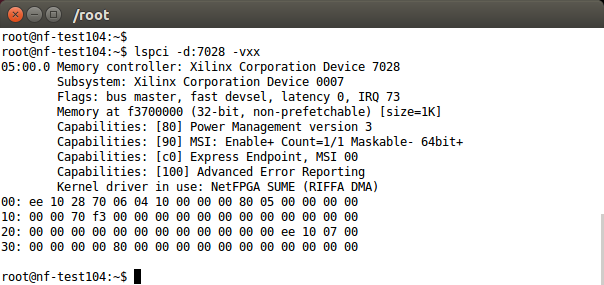-
Notifications
You must be signed in to change notification settings - Fork 46
Restore PCIE Configuration
This page describes restoring PCIE configuration on NetFPGA-SUME to avoid rebooting a host PC after programming FPGA. In the projects, a host PC installed a NetFPGA-SUME card is required to reboot after programming FPGA with the bit file. It is because of some of PCIE configuration disappearing in the FPGA programming. While PCIE configuration are scanned by a root complex during the booting, some of PCIE configuration are lost by the FPGA programming and it is required to reboot the PC for restoring the PCIE configuration. This rebooting issue can be avoided by workaround steps on below.
-
Power on a host PC and prepare a bit image file for HW test.
-
Reboot the host PC. Run 'lspci -d:7028 -vxx' on a terminal and check whether it shows like on below.

-
Test HW configured with the bit image file.
-
Generate another bit file.
-
Without rebooting a host PC, run following steps
$ rmmod sume_riffa
$ bash $SUME_FOLDER/tools/scripts/reconfigure/pci_rescan_run.sh
$ insmod $DRIVER_FOLDER/sume_riffa.ko
This restores PCIE configuration as initial configuration.
-
Run 'lspci -d:7028 -vxx' and check the PCIE configuration. If it does not show any PCIE configuration, you may need either to check DMA core used to generate the bit file or to repeat the steps in 9).
-
Test HW.
The script command of pci_rescan_run.sh restores PCIE configuration, and a host PC can run HW test without rebooting after programming the FPGA.